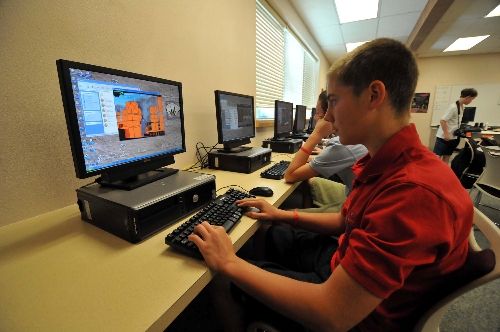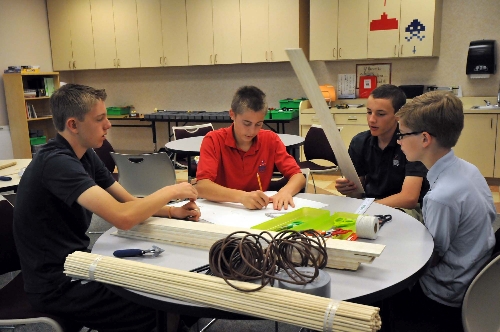Students use video game to explore engineering concepts at Alexander Dawson



Stranded in Alaska after a devastating earthquake, students must quickly build a shelter to prevent the onset of hypothermia.
That is the scenario some eighth-graders were given at The Alexander Dawson School, 10845 W. Desert Inn Road.
Dawson was selected as one of 12 pilot sites in the country to test a multiplayer computer game that teaches middle school students engineering and technology concepts. Students must pass 10 different game levels set in the Alaskan tundra. The levels teach the surface area and volume of geometric shapes, conductive heat flow, structural design and more.
After more than a month of working through the levels, groups of students must build one-quarter-scale models of their proposed shelters. The shelters should accommodate four adults sleeping side by side on the floor or sitting up comfortably.
The challenge is part of the Survival Master program, a two-month unit of the Technology Mashup elective course taught by Camille McCue.
McCue said this interactive teaching approach is more effective at engaging students. They learn more than they would taking multiple-choice tests, she said.
“These guys know video games,” McCue said. “This is a game that actually puts them in a situation where they are using materials and concepts to achieve a goal.
“They apply what they learn in a real-world context.”
The overall goal of the program is to get students to understand the heat equation, which explains the transfer of heat in a given space over time.
The shelters’ frames can be constructed using twine, straw, dowel rods, plastic tubing, balsa sticks, hand shears, duct tape and a hot glue gun.
McCue and the Survival Master developers are aware of the absurdity of a functioning hot glue gun being used in the Alaskan wilderness. For the purposes of the class, she said, it was found to be nearly impossible to hold a shelter together without hot glue.
The shelter will be covered with materials that do not transfer heat well, such as foam, cotton, paper and cardboard. Some students designed domes, others pyramids.
The shelters’ functionality and resilience will be tested once they are completed in the next few weeks. The temperature inside the shelter must be 20 degrees warmer than the outside, and a 100-watt light bulb will simulate the heat generated by four human bodies.
The mini-shelters must sustain a 15-mph wind and hold up under a snow load of 6 pounds per square foot. Sand-filled zip-close bags will serve as snow.
Students do not have to worry about the problems of errant bears or food.
Hofstra University in New York partnered with Bloomsburg University in Pennsylvania to create the program. The universities received funding from the National Science Foundation to develop a 3-D educational computer game that teaches science, technology, engineering and math concepts to middle school students.
Students Ted Murren and Jonathan Walton designed a dome shelter with two other teammates. They said the class has been one of their favorites this semester.
“We’re not just sitting in a classroom and taking tests,” Jonathan said. “We learned engineering principles on the computer, and we’re using that experience. (McCue) gives us the freedom to work on our own, but she’s also strict.
“It’s just really fun.”
Contact View education reporter Jeff Mosier at jmosier@viewnews.com or 224-5524.












